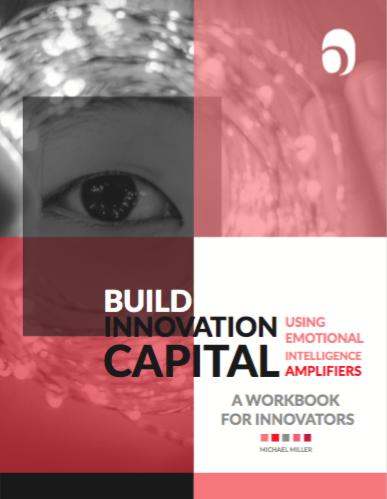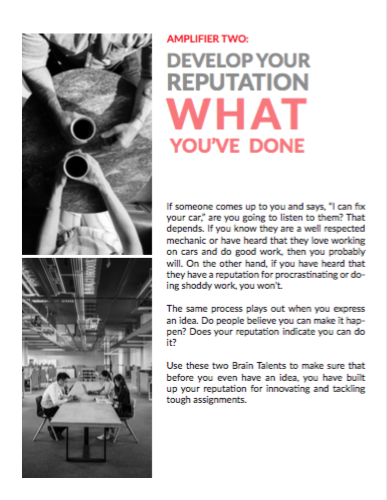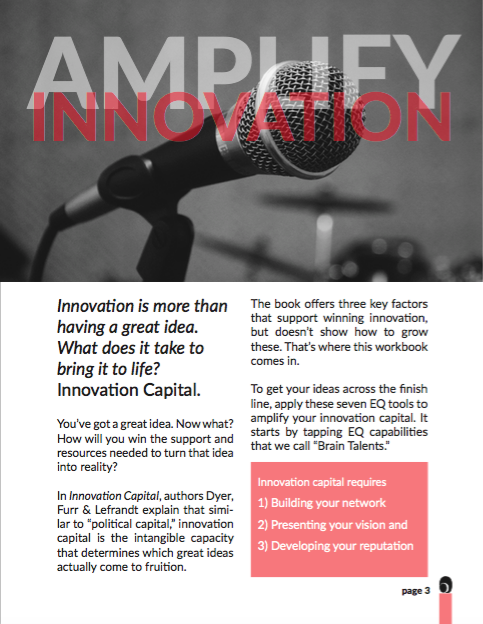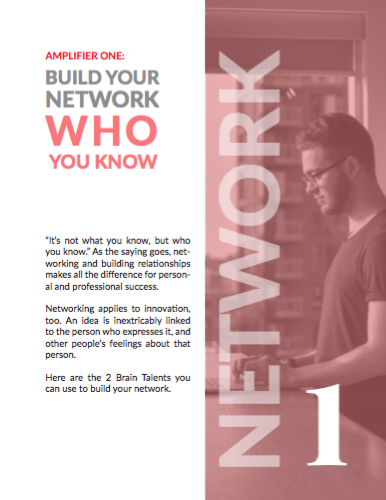“A Great Idea Isn’t Enough”: 7 Emotional Intelligence Amplifiers to Build Your Innovation Capital
Innovation capital is the ability to win support for and implement your ideas. We’ve identified the 7 emotional intelligence skills you can use to build this crucial capacity.
Do you ever feel like you struggle to get support for your innovative ideas, while others’ less impressive ideas get turned into reality? Why do some people’s ideas get adopted and others don’t?
It can be tempting to think that the best ideas win, but as you may know firsthand and the story below illustrates without a doubt, innovation is not so simple. Generating a great idea is just the first step. Ultimate success depends on your ability to win the support and resources needed to turn that idea into reality – an ability that a trio of authors have dubbed your innovation capital. Like political capital, innovation capital is an intangible set of conditions – a mix of your reputation, network, sales ability, and more – that determines your capacity to implement your innovative ideas.
To understand the importance of innovation capital, look no further than two of the greatest inventors of all time: Albert Einstein and Nikola Tesla.
Build your innovation capital + elevate your ideas
Download our FREE workbook for innovators
Why innovation capital matters
Born in the same era, both Edison and Tesla were prolific innovators who changed the world in profound ways.
Edison is credited with inventing the motion picture camera, the alkaline battery, the phonograph and, most importantly, the electric light bulb. Not bad, huh? Tesla was no slouch either. He developed the foundations for electric induction motors, wireless telegraphy, radios, neon lamps, remote control – and, most importantly, three-phase electric power and alternating current inventions that made possible the global distribution of electricity as we know it. That’s to say, Tesla made Einstein’s light bulb invention far more accessible and profitable.
Even though Tesla’s ideas were arguably more impactful, he wasn’t able to commercialize them. While Edison received the Congressional Medal of Honor and died in a mansion, Tesla died penniless and frustrated. Why did the two go down such different paths? Part of the answer is due to differences in innovation capital, or as Forbes described it: “Edison’s ability to win backers, collaborators, and attention for his ideas.” He took a multifaceted approach to funding, promoting and spreading his inventions. He developed relationships with financiers, journalists and other inventors – and then he tapped into that network to advance his innovations. When he had a commercially viable lightbulb, for example, JP Morgan lent him $30,000 to start the Edison Electric Light Company. When he invented the phonograph, he took it to the office of Scientific American to show it off, and they ended up writing a feature story about it. In addition to these relationships, Edison cultivated his own reputation and the narrative around his inventions. Tesla had no such ability and met much failure and disappointment, even though his ideas were equally brilliant. The best idea doesn’t always win; the idea whose inventor has innovation capital does.
While Edison and Tesla were uniquely brilliant inventors, this situation plays out on a smaller scale every day, at organizations throughout the world. Brilliant ideas go undeveloped because the employee hasn’t developed one or more of the interrelated factors that make up innovation capital.
Let’s look at the 3 factors that make up innovation capital and how to build each with emotional intelligence.
3 factors that make up your innovation capital
In Innovation Capital: How to compete – and win – like the world’s most innovative leaders, the authors argue that it’s a combination of 3 factors that make up your innovation capital – who you are, who you know, and what you’ve done.

1. Who you are, or your vision. Can you frame the idea in a way that helps win buy-in? The pitch for your idea may be very different to a visionary CEO and a pragmatic engineer – everyone has different needs, fears, and motivations. Can you create a narrative about your idea and the problem it solves that entices others to want to follow you? And even more fundamentally, have you developed a clear vision of your idea, including its potential drawbacks?

2. Who you know, or your network. Can you build connections to the kinds of people who will help you get things done? It could be within your organization, outside of it, or some combination of the two. Have you cultivated relationships with the decision makers who ultimately decide how money and other resources are appropriated? Have you cultivated relationships with coworkers whose support you will need, and influencers who can help move your project forward?

3. What you’ve done, or your reputation. Do you have a reputation as someone who can handle difficult assignments? As someone who can navigate setbacks and find creative solutions to complex issues? If you want to develop your reputation as an innovator, lead a project or initiative inside your company or department. By leading visible, hard projects, you prove to others that you can get the job done, which infuses all your ideas with credibility.
These factors combine to make your innovation capital. What specific steps can you take to develop them?
How to build innovation capital
To develop innovation capital, author Nathan Furr lists 7 actions – which he calls impression amplifiers – that people use to elevate their ideas. You can check out his list here.
We’ve added to his model by identifying 7 emotional intelligence amplifiers – the Brain Talents in the Six Seconds Model of EQ that are most essential for building innovation capital. They are broken down by the 3 factors of innovation capital: network, reputation and vision.

Just fill in this form to download our free Workbook for Innovators




- Pursue Noble Goals in the Six Seconds Model of EQ - July 29, 2023
- Increase Empathy in the Six Seconds Model of EQ - July 26, 2023
- Exercise Optimism - July 24, 2023

Thank you for the useful things
Thank you, Charles!
Thank you for this tool – great tool!
Thank you, Makeda!
No comment
Six Seconds is doing fantastic job on EQ awareness as well as implementation in community life.
It also helped me to withstand the toughest moments in my life ( other people opt for suicides) while it also helped me in my professional life to succeed.
I also nurtured EQ among young generation & today, I can see the results with happiness ( over 10 years span)
Different topics of EQ are with prolific writing & with substance.
Salute to Six Seconds.
Hi Deepak, thank you for the kind words. Six Seconds has been similarly transformational for me to – what a gift it is to have a community like this to nurture people’s emotional intelligence!
Keep practicing and doing great work!
Thank you from South Africa for this valuable tool.
Hi Julia, thank you for reading and using this valuable tool!